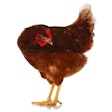
Over the past 10 days, new outbreaks of highly pathogenic avian influenza (HPAI) involving domestic poultry have been reported in 11 countries across Europe. While the outbreaks are widespread, most of the nations have registered just one or two newly affected premises, mainly in small backyard flocks.
This is according to the European Commission (EC; as of January 27). Its Animal Disease Information System covers the animal disease situation in European Union (EU) member states and neighboring countries.
Compared with the previous edition from January 19, this was an increase of 10, which includes the first cases of the year in Croatia and Denmark.
Of the total outbreaks, 25 have occurred in Moldova, seven in Hungary, five in Germany, four in Poland, and three in Bulgaria. Of these nations, only Poland’s total remained unchanged from the previous update.
Although identified by the Moldovan agency as outbreaks in commercial poultry, each of the premises affected so far has been described in WOAH reports as a “backyard,” and involved no more than around 75 birds.
HPAI hiatus ends for 4 European states
Official notifications from the national veterinary authorities to the World Organisation for Animal Health (WOAH) provide further details on these developments.
To this agency, the first HPAI cases following a hiatus have been reported by Bulgaria, the Czech Republic (Czechia), Denmark, and the German state of Hesse.
Since early January, outbreaks have been confirmed at three poultry farms in the central Bulgarian province of Plovdiv. These were the first cases in this region since March of 2023. Located in close proximity to one another, each of the premises had between around 4,000 and 8,000 birds.
In the Pardubice region in central-eastern Czech Republic, the HPAI virus was detected at a farm with 69,100 broiler breeders at the end of January. This was the first outbreak following a six-month hiatus since the previous outbreak. The source of the latest infection was thought to be wild birds.
Last week, the state veterinary service, a second HPAI outbreak has been confirmed in the same region. The farm had 20,200 breeding poultry.
Following an absence of about four weeks, the HPAI virus was detected again in a Danish poultry flock during the third week of January. Affected were 24,000 turkeys on the easternmost main island of Zealand.
In Hesse, presence of the virus was confirmed at the end of last month after elevated mortality was observed in a commercial flock of 15,000 laying hens. This followed a hiatus of more than 12 months in this east German state.
Further outbreaks on farms in France, Poland
Poland’s total number of HPAI outbreaks on poultry farms stands at seven, according to the chief veterinary office (as of January 31).
The latest confirmed infection was in a flock of 10,860 broiler chickens in the central-western province of Greater Poland. The authority had previously notified WOAH about an outbreak affecting 30,654 birds of the same type in Lublin in the east of the country.
The newest update from the French agriculture ministry puts the latest total for confirmed HPAI outbreaks in poultry at 10. This most recent confirmed outbreak was at a duck farm in Vendée, and started on January 18. It was the third such flock to be infected in this department in the west of the country.
Earlier in this disease wave — which began in November of 2023 — HPAI was detected in six flocks of housed turkeys, and one of laying hens across four different departments.
In all of these outbreaks, the virus responsible for the outbreaks was identified as the H5N1 serotype.
5 states record new cases in captive birds
According to the latest EC System update, five nations in Europe have so far registered HPAI cases in this category, which includes non-commercial poultry, zoos, and similar premises.
Of the total of 26, 13 were reported in the Czech Republic, six in Ukraine, four in Germany, two in Austria, and one in Slovakia.
Since the EC’s earlier edition dated January 19, totals for the Czech Republic and Ukraine have each increased by one.
Meanwhile, the authority in the Republic of Moldova has notified WOAH about six further outbreaks affecting backyard flocks. Four of these occurred in districts in the Central region, and two in the Northern region. These include the first cases for more than 10 months in Straseni and Glodeni, which are districts in the same regions, respectively. .
Based on WOAH notifications, one further outbreak affecting a backyard flocks has been confirmed in each of Germany’s eastern state of Brandenburg, and in Lower Saxony in the northwest.
The latest cases in Austria were detected in a group of non-commercial poultry in the southern state of Carinthia.
HPAI cases in wild birds widespread across Europe
Since the previous update to its System, the Czech Republic has been added to the list of European states reporting cases of HPAI in wild birds. So as of January 27, 20 European countries have registered infections in their respective wild bird populations with the EC.
Of the total of 120 outbreaks, 29 have been in Germany, 17 in Denmark, and 13 in Romania. For each of the other countries, the total so far is no more than seven
According to recent notifications to WOAH, one of the 14 latest HPAI-positive wild birds reported by Germany, one was infected with the H5N5 HPAI virus serotype. The H5N1 variant was involved in all the other recent wild birds cases in Germany — and indeed, Europe-wide.
Not monitored by the EC’s System is the disease situation in the United Kingdom (U.K.). However, two more case in wild birds have been confirmed in southern England, according to the latest official notification to WOAH.
The HPAI virus lineage currently circulating has been the most destructive in more than 100 years. This is according to a globally recognized poultry disease expert, who was speaking at a recent international event.
View our continuing coverage of the global avian influenza situation.

















